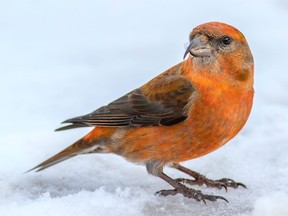BIRDWATCH: An abundance of pinecones lead to Red Crossbills in Renfrew County

Article content
This winter, the northern and rural parts of Renfrew County are experiencing a small irruption of Red Crossbills. In fact, these birds were located on both our Eganville and Pembroke Christmas Bird Counts this past December. These birds are also apparently quite abundant now in the boreal forest of Algonquin Park. This is not surprising as we have been experiencing two great years of pinecone production throughout the area, the main food of these birds.
The Red Crossbill (Laxia curvirostic) is a resident of evergreen and mixed forests. All Crossbills get their name from the overlapping tips of their upper and lower mandibles. The Crossbill inserts these crossed mandibles into conifer cones, forcing the scales apart while its tongue scoops out the seeds into the Crossbill’s mouth.
The male Red Crossbill is reddish overall with dusky wings and red edgings and a short black tail. The female of this species is mainly yellowish green overall with dark black wings. Both the male and female have the characteristic crossed bills.
The Red Crossbill forages for food in conifer trees and on the ground. It eats mostly conifer cone seeds, insects, and caterpillars. It is also attracted to salt licks and winter salt on the side of roadways.
This Crossbill is monogamous and is a solitary breeder. If abundant food is available, it may begin to nest as early as January. The male attracts the female by displaying above the female in flight. The male will vibrate its wings while singing a flight song.
The nest of the Red Crossbill is cup-size and is located on a tree branch far from the trunk, anywhere from 6-40 feet above the ground. The nest is made of twigs, pieces of bark, grass, and rootlets. It is lined with finer grasses, feathers, fur, hair, and moss.
The Red Crossbill has one to two broods per year. The eggs of the Crossbill are incubated by the female for 12-18 days, and the young remain in the nest for another 15-20 days where they are fed by both sexes.
It is interesting to note that the nestlings have straight bills when born and do so for about three weeks out of the nest. At that point, the mandibles on the juvenile Crossbills begin to gradually cross.
The Red Crossbill is common throughout Canada’s boreal forest, both in the east and west. It is also found in the northwest states and parts of the central states where conifer forests exist. Its range extends well into Central Mexico.
It is always nice to see Red Crossbills as they tend to wander long distances in search of conifer cones. Hopefully, I will get to see some this winter.
The local scene
On the local scene, there have been more winter migrants entering our region. These include large flocks of Snow Buntings and Bohemian Waxwings, as well as small numbers of Evening Grosbeaks, Purple Finches and Horned Larks.
If the weather remains mild and we avoid any major snow or ice storm in early March, we should get some of the first wave of spring birds and a slow trickle of some of the northern migrants returning from southern Ontario. The spring migrants will include American Robins, Red-winged Blackbirds and Common Grackles. There should be some Canada Geese flying with some Snow Geese among them.
Over the next few weeks, you can expect the arrival of Killdeer, American Woodcock, Eastern Bluebirds, Rusty Blackbirds and perhaps some Ring-billed Gulls. The number of Rough-legged Hawks will pass through to be replaced with Red-tailed Hawks, American Kestrel and Northern Harriers.
When the rivers start to open, you can expect Mallards, Hooded Mergansers, and if lucky, the odd Blue Heron along the river edges.
Finally, as this is the mating time for Barred and Great Horned Owls, I suspect the number of sightings of these birds will increase. So far, I have had no reports of Snowy Owls in the area. I remind people not to harass these Owls by chasing them, feeding them, getting too close or interfering with their hunting. Take your picture a little further back and then leave.
Local sightings
Back on January 25, Clare Metcalfe spotted five Ring-necked Ducks and a rare Canvasback Duck in an open stretch of water in Balmer’s Bay. Nice find!
On January 30, Nancy Stead Wilcox spotted a large flock of Snow Buntings in the area. She also was fortunate to have a Northern Shrike frequenting her bird feeder. Around this same date, Cat Harrison photographed a nice male Purple Finch in her area.
On February 1, Robert Mayo photographed a flock of American Tree Sparrows, Dark-eyed Junco and an over wintering White-throated Sparrow. Around this same period, Raymond and Melissa Cousineau observed a Pileated Woodpecker at their suet.
Finally, on February 7, Wade Lumax posted a picture of a Short-eared Owl on Facebook. He mentions that there was at least 20 at one point where he took the picture. I suspect the photo was taken on one of the islands in the St Lawrence River.
Please call me with your bird feeder reports and sightings at 613-735-4430 or email me at hooles@bell.net . For more information on the Pembroke Field Naturalists’ upcoming events or other links to nature sites, just google the club’s website or like us on Facebook.
Postmedia is committed to maintaining a lively but civil forum for discussion. Please keep comments relevant and respectful. Comments may take up to an hour to appear on the site. You will receive an email if there is a reply to your comment, an update to a thread you follow or if a user you follow comments. Visit our Community Guidelines for more information.